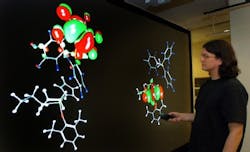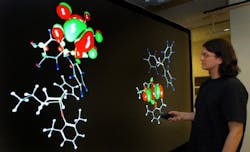Molecular modeling advances in 3-D
A team of scientists at Purdue University, West Lafayette, Ind., is using high-performance computing (i.e., mainframe and supercomputers to solve problems that are too big for a single workstation) and artificial intelligence software to create a “data-rich” environment that will display information and interact with researchers to aid scientific discovery. The method, called “discovery informatics,” represents a fundamental shift from more conventional techniques in computer-aided scientific discovery.
This method will extract knowledge from data, promising to speed up the process of discovery in many areas of research, including work aimed at creating new drugs, fuel additives, catalysts and rubber compounds.
“If you were a chemist, you could walk right up to this display and move molecules and atoms around to see how the changes would affect a formulation or a material’s properties,” says James Caruthers, a professor of chemical engineering at Purdue.
Discovery informatics has numerous potential applications. “The opportunities are enormous for engineers who work in product design, which is now largely done as an art form by formulation chemists,” Caruthers says. “We want to retain the creative aspects that can only come from the human mind, while reducing the amount of guesswork now needed to create new catalysts and other materials.”
With conventional methods, it might take several years and thousands of tests before hitting on the right formulation, whereas discovery informatics dramatically speeds up the process by using a computer to sample potential materials and requires a fraction of the usual number of laboratory experiments.
The method enables researchers to test new theories on the fly and to see how well their concepts might work in real time via a 3-D display, says Venkat Venkatasubramanian, another professor of chemical engineering who is working to develop the new system.
Discovery informatics could help scientists deal with the explosion of data now available to them. “You run the risk of drowning in data,” says W. Nicholas Delgass, a Purdue professor of chemical engineering. “What you really want is knowledge, not data.”
The source of this flood of data is high-throughput experimentation, in which hundreds or thousands of experiments are conducted simultaneously in tiny vessels that are sometimes as small as a few human hairs. Having so much information presents a challenge and makes it difficult for researchers to find what they are looking for.
The method will be tested in a new Center for Catalyst Design, which officially opened in August. Delgass is the head of the center, which is funded with a three-year, $2.4-million grant from the U.S. Department of Energy and $1.7 million from the Indiana 21st Century Research and Technology Fund, established by the state to promote high-tech research and to help commercialize university innovations.
Discovery informatics
